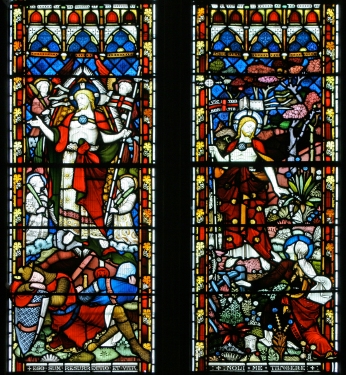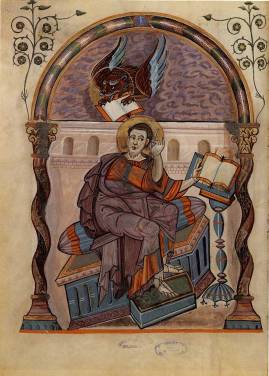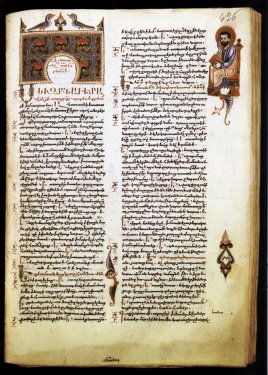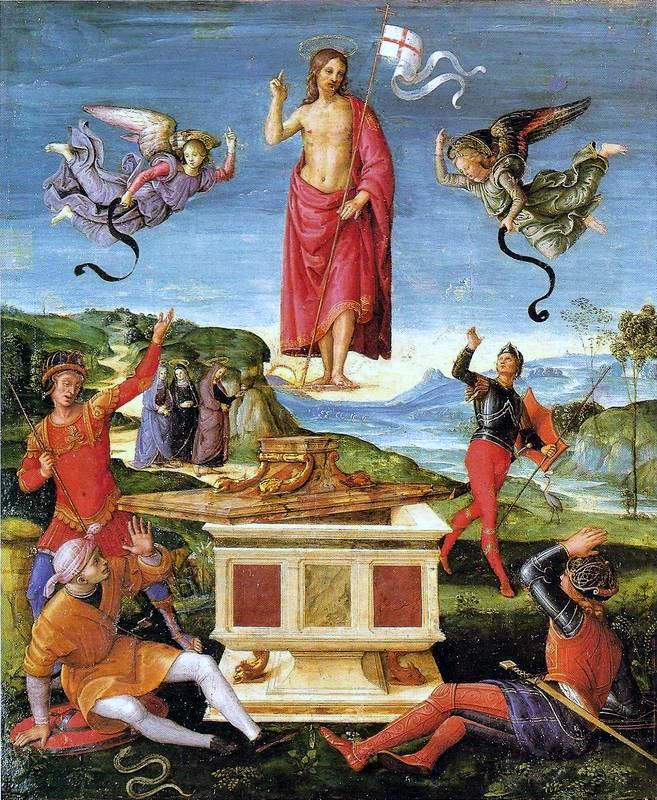Happy Easter! This is the sermon I preached today at Putney Methodist Church. The set reading was the account of the resurrection from Mark’s gospel: Mark 16:1-8.
Today is, as you all know, April Fool’s Day. The day when people traditionally play pranks on one another, and our newspapers drop in a few fake stories to try to fool us into believing that there are such things as spaghetti trees, and the like. It also happens to be Easter Sunday, as I am pretty sure you also all know. Given that Easter can fall on any Sunday between 22nd March and 25th April, that is not terribly shocking, and indeed – according to Wikipedia – it will happen again in 2029. I shall be sure to save this sermon for re-use then!
 This coincidence of dates has already given rise to much comment and some mockery in the media and online. There will no doubt be several commentators today who suggest that the billions of Christians across the globe celebrating Easter with us are, in fact, being taken for April fools. We will be told again that the resurrection story is just an elaborate prank or myth. Nothing more than “a conjuring trick with bones”, as a former Bishop of Durham allegedly said.
This coincidence of dates has already given rise to much comment and some mockery in the media and online. There will no doubt be several commentators today who suggest that the billions of Christians across the globe celebrating Easter with us are, in fact, being taken for April fools. We will be told again that the resurrection story is just an elaborate prank or myth. Nothing more than “a conjuring trick with bones”, as a former Bishop of Durham allegedly said.
This is nothing new, of course. Similar suggestions have been made ever since the time of Jesus and, while untrue, they challenge all of us to reflect upon our own understanding of the Easter story. Many of our hymns today speak of the absolute triumph of faith on this day. As we shall shortly sing:
No more we doubt thee,
glorious prince of life
Yet the truth is that we all have doubts and questions about the Easter story and exactly what happened.
One of the passages of scripture that gives me such faith in the Easter story, though, is that curious ending from Mark’s gospel – or the lack of an ending really – which we have just heard read. Some of us have been studying Mark’s gospel this Lent and I hope that we all found it a very useful and fulfilling experience – I certainly did. We are so used to hearing a conglomeration of the gospel stories, especially in Holy Week, that it is helpful occasionally to focus in on one particular evangelist’s viewpoint and style.
 Mark, as most of you will know, was almost certainly the first gospel to be written, perhaps 30 or 35 years after Jesus’ crucifixion. Perhaps unsurprisingly therefore, as one participant in the Lent course observed, it often has the feel of a first draft. This is not to deny its wonderful narrative style and pace, often breathlessly driving the action on, where the other gospels linger awhile. We also highlighted those places where we seem to detect the extra details about a scene that only an eyewitness could have given, and many of us felt that the stories often feel like they were transcribed from someone speaking aloud, rather than an author sitting alone at his desk. Perhaps they come from the apostle Peter himself, who has often been associated with Mark’s gospel, telling and re-telling the stories to the first Christians as he travelled across the Mediterranean. It really is a wonderful and endlessly rewarding text. Yet for all that there is an undeniable rawness and lack of polish to the text. Matthew, when he copied large sections into his own gospel, even had to correct Mark’s grammar and syntax!
Mark, as most of you will know, was almost certainly the first gospel to be written, perhaps 30 or 35 years after Jesus’ crucifixion. Perhaps unsurprisingly therefore, as one participant in the Lent course observed, it often has the feel of a first draft. This is not to deny its wonderful narrative style and pace, often breathlessly driving the action on, where the other gospels linger awhile. We also highlighted those places where we seem to detect the extra details about a scene that only an eyewitness could have given, and many of us felt that the stories often feel like they were transcribed from someone speaking aloud, rather than an author sitting alone at his desk. Perhaps they come from the apostle Peter himself, who has often been associated with Mark’s gospel, telling and re-telling the stories to the first Christians as he travelled across the Mediterranean. It really is a wonderful and endlessly rewarding text. Yet for all that there is an undeniable rawness and lack of polish to the text. Matthew, when he copied large sections into his own gospel, even had to correct Mark’s grammar and syntax!
For me, though, this is a wonderful strength of the book not a weakness. If he had been setting out to deceive, to trick, to make April fools of us all, he simply would have done a better job! He would have spun his ‘fake news’ better – smoothed out the wrinkles, omitted all the embarrassing facts, and provided ready-made answers to some of the contentious issues of his own day. Instead, he provides us with a ‘warts and all’ record of the ministry of Jesus, including a devastating critique of the men who came to hold positions of great importance in the early church, the apostles.
 There is no better example of this than the Passion narrative in Mark’s gospel. At our last session, we read through this whole section, from the beginning of chapter 14 to the end of today’s reading, in one go. Despite its familiarity, we were deeply moved by what we read. Mark does nothing to hide the despair and loneliness of Jesus in these last few hours before his death. One by one his friends desert him, starting with Judas and ending with his closest companion, Peter. All those whom he has come to serve and whom he has helped so willingly, turn their backs on him at this hour of need. And finally, even God seems to abandon him. That heartbreaking cry of dereliction on the cross: “My God, my God, why have you forsaken me?” (Mark 14:34). A troubling and disturbing cry for one who claimed to be the true Messiah, the Son of God. A verse that a cleverer and more deceitful editor would simply have removed.
There is no better example of this than the Passion narrative in Mark’s gospel. At our last session, we read through this whole section, from the beginning of chapter 14 to the end of today’s reading, in one go. Despite its familiarity, we were deeply moved by what we read. Mark does nothing to hide the despair and loneliness of Jesus in these last few hours before his death. One by one his friends desert him, starting with Judas and ending with his closest companion, Peter. All those whom he has come to serve and whom he has helped so willingly, turn their backs on him at this hour of need. And finally, even God seems to abandon him. That heartbreaking cry of dereliction on the cross: “My God, my God, why have you forsaken me?” (Mark 14:34). A troubling and disturbing cry for one who claimed to be the true Messiah, the Son of God. A verse that a cleverer and more deceitful editor would simply have removed.
Then we have that strange and mystifying ending. Not the glorious vindication of this rejected Christ but merely an empty tomb and a few women running away, seized by “terror and amazement” (16:8). If you were going to start an international deception, that is not how you would record it – and you certainly would not have based your testimony upon that of a few foolish women, whose word counted for very little at that time. Were you seeking to make April fools of a third of the population of the planet, you would have done a much better job of hiding your tracks!
Now the truth is that the ending of Mark’s gospel most likely got lost somehow, as often happened to ancient documents. It almost certainly originally ended with some of the same incidents as Matthew and Luke record. Yet, there is something wonderfully reassuring about these verses, and the fact that they were not suppressed by the early church. They record the genuine human emotions of people encountering something completely beyond their understanding. The terror and fear of the women are real, and Mark seems to have no qualms whatsoever about recording them. He does not seek to edit out their reactions and put them into a ‘stained glass attitude’ instead. He would only need to have done that, if he had had something to hide or if he wished to deceive us. And that was not his purpose in writing.
 He was not seeking to make April fools of us all. Instead, he wished to set down honestly and without omission the record of what his first readers knew to be the truth. The story that they knew so well, and which they had heard from the lips of eyewitnesses for decades, who had become the first preachers of the early church. The story that the tomb was empty. That the women did see something amazing. That Jesus had truly risen from the dead.
He was not seeking to make April fools of us all. Instead, he wished to set down honestly and without omission the record of what his first readers knew to be the truth. The story that they knew so well, and which they had heard from the lips of eyewitnesses for decades, who had become the first preachers of the early church. The story that the tomb was empty. That the women did see something amazing. That Jesus had truly risen from the dead.
Whatever the women and the apostles saw in that tomb – or perhaps more importantly did not see – changed their lives forever. It made them abandon homes and families and careers, and become itinerant preachers, travelling thousands of miles between them and dependent upon the charity of others. It made them give up some of the most central tenets of their faith: their dietary laws, their Sabbath, even their belief that God could never have a son. It made them willing even to put their own lives on the line, so that you and I may hear this good news today.
This is no April fool, brothers and sisters. It is incredible. It is astounding. It is world-changing, and it seems unbelievable. If it had not been, then the women in our story today would have just neatly folded up the grave clothes and calmly walked home. Yet it is the truth. Pure and unvarnished by Mark. That somehow, in a mystery that we shall never fully understand in this life, God raised Jesus Christ from the dead on that first Easter Sunday, and that through that action, the power of sin and death over us all was vanquished forever.
This is no April Fool. This is no ‘fake news’. This is no ‘conjuring trick’. It is the truth; and it is good news for you and for me, and for everyone, forever. Alleluia. Amen.
